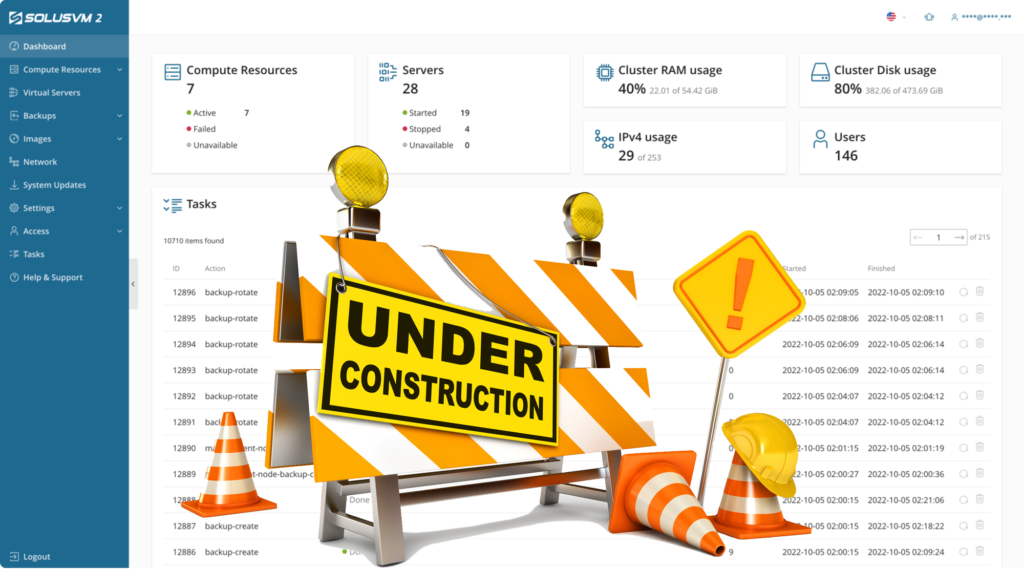
SolusVM 2.0 has been released, and one provider has compiled a detailed review of the product. This isn’t some website feature-comparison checklist, but a report from the trenches from an industry leader.
Spoiler alert: it ain’t pretty.
Here’s a hot take from Dustin Cisneros, CEO of RackNerd:
“…while it is off to a great start and it certainly has a much more visually-appealing interface, it is still missing some core features that SolusVM 1 previously had, and V2 is essentially SolusIO rebranded as SolusVM 2.”
Wow.
This is disappointing given the Duke Nukem Forever-scale gestation period for SolusVM 2.0. Some key problems:
- At present, for prepaid customers (i.e., you) “here is no frontend access for customers to manage their VPSs with SolusVM 2”. Um, isn’t that whole point?
- No ability to mount a custom ISO. That’s a big step back.
- No way to assign additional IPs to a system.
- No snapshots on existing SolusVM 1 nodes. Snapshots were a key promised feature.
- Reselling features are gone.
And there’s more, but those are the top five that jumped out at me.
Now Dustin did include some praise. The interface got a big boost (how could it not!) and the whole platform was substantially modernized. Yet there’s no doubt that at launch, SolusVM did not deliver what its paying customers expectred.
It’s a pretty intense read, so here we go. Big thanks to Dustin at RackNerd for the detailed analysis! You should check out their latest offer and also follow the corresponding thread on LowEndTalk.
SolusVM 2.0 Feedback
Our Thoughts & Findings (and what is in the pipeline)
Dustin Cisneros
CEO of RackNerd
We dug into SolusVM 2 since it was released back on October 17, and wanted to share our initial impressions with the community, as well as our findings, which we believe will ultimately benefit providers in the SolusVM ecosystem (and thus benefitting the end-user).
We spent a considerable amount of time testing SolusVM 2 internally since it was released, and found that overall, while it is off to a great start and it certainly has a much more visually-appealing interface, it is still missing some core features that SolusVM 1 previously had, and V2 is essentially SolusIO rebranded as SolusVM 2. To further illustrate this fact, solus.io now redirects back to SolusVM’s website. Work needs to be done to SolusVM 2 before it can be suitable for hosting providers currently on SolusVM 1. The good news is that the SolusVM team has been quite supportive and receptive to our feedback in the numerous interactions we’ve had with them so far, and based upon the findings we provided so far, they are working to implement those features & changes in upcoming SolusVM 2 releases to make SolusVM 2 better for everyone!
Below is what I am able to share so far, please find our notes below, which may be helpful for fellow providers utilizing SolusVM to know about, so you can make an informed decision as to whether or not you plan to stay on SolusVM 1 (for as long as it is supported), transition to SolusVM 2, or explore alternate options:
- With the importer tool that SolusVM plans to release in Q1 of 2023, they will be doing a “take over” which will be an installation of agent on the existing SolusVM slave nodes (now referred to as “compute resources” in SolusVM 2). The importer tool will cover everything that is necessary for VPS functions and management, such as IP blocks, plans, etc. The importer tool is also going to complete the process of converting the slaves (now compute resources) automatically, so that you do not need to manually log into each hypervisor and transition it one by one.
- We brought up additional suggestions and feedback on how the importer tool can be better tailored for existing hosting providers utilizing SolusVM 1, specifically, with WHMCS as well. On that front, SolusVM developers are currently researching our suggestions on how they can be implemented. I will share more news on this when I am able to.
- In our testing, we got the overall feeling that SolusVM 2 (previously SolusIO) was designed with a focus on postpaid billing model. SolusVM support confirmed this when we asked. For example, right now for prepaid VPS customers (essentially the type of VPS deals we have all come to know and love here on LEB/LET) there is no frontend access for customers to manage their VPS’s with SolusVM 2. The good news is that SolusVM developers plan on changing and improving this. In a future release, prepaid users will be able to access SolusVM 2 UI and manage their VPS’s just like they are now with SolusVM 1.
- For hosting providers who currently leverage the reseller feature in SolusVM 1, this will no longer be a feature in SolusVM 2. If you are a hosting provider and are currently utilizing this feature in SolusVM, we advise you to plan to transition off accordingly.
- SolusVM 2 currently only supports snapshots for compute resources that utilize either file-based QCOW2 and ThinLVM storage type. For regular LVM, which existing SolusVM 1 nodes are set up as, snapshots are not supported. We spoke with the SolusVM team concerning this and they have created a case for this, to be addressed in a future update.
- SolusVM 2 will not utilize ebtables at all anymore and will instead utilize Open vSwitch for network management. This is great news!
- SolusVM 2 utilizes cloud-init for OS images, and is no longer based on templates. In comparison, SolusVM 1 utilized hypervisor mounts and libguestfs to handle OS templates. With SolusVM 2, official cloud distro images can be pulled directly from the OS upstream as well. See https://github.com/solusio/solus-cloud-images for more information.
- There are currently no OS images from Solus/OS upstreams that support GPT out of the box, this will effectively restrict VM’s to a maximum disk size of 2 TB. Custom images will need to be created for large storage VM providers.
- There is currently no ability to mount a custom ISO in SolusVM 2. For the time being, if you are utilizing SolusVM 2, you will need to mount an ISO manually using native KVM tools by following the instructions here: https://support.solusvm.com/hc/en-us/articles/360015728600-Is-there-a-possibility-to-mount-ISO-images-in-SolusIO – a future update will address this and allow for custom ISO support
- In our testing, we learned that there is currently no way for an administrator to assign additional IP address(es) to a VPS. We brought this to SolusVM’s attention and they have created a case for this, to be addressed in a future update.
- In our testing, we learned that there is currently no way to enable optional backups via the WHMCS module as a configurable option. We brought this to SolusVM’s attention and they have created a case for this, to be addressed in a future update.
- In our testing, we learned that there is no way for an administrator to search for a VPS by its IP address in V2. We brought this to SolusVM’s attention and they have created a case for this, to be addressed in a future update.
- In SolusVM 2, when initiating a migration, you can choose to either retain the same IP address, or automatically change the IP of the VPS upon successful migration. We submitted a suggestion to SolusVM support to subsequently automatically update the corresponding service’s IP address in WHMCS if the latter option is chosen, and they have created a case for this, to be addressed in a future update.
- In our testing, we learned that there is currently no way to search for a VPS in the administrator area by hostname, vserverid, or kvmID. We brought this to SolusVM’s attention and they have created a case for this, to be addressed in a future update.
- In our testing, we learned that there is currently no way to “lock” a compute resource node, similar to the way you can lock/unlock nodes for new orders/provisioning now in SolusVM 1. We brought this to SolusVM’s attention and they have created a case for this, to be addressed in a future update. As a temporary workaround, you could remove a Compute Resource from the location by going to SolusVM 2.0 > Compute Resources > Locations, opening the edit page of the corresponding location and removing the CR from the location.
- Please note that there is currently no way to migrate between compute resources that utilize regular LVM, to a destination CR with ThinLVM. SolusVM developers are planning to add support for such migrations in the future. We made a recommendation to the SolusVM developers in the past to implement MAC – IP verifications to better handle IP stealing which is something SolusVM 1 lacked. We are very pleased and excited to say that this feature has finally been implemented in SolusVM 2. The previous method of utilizing ebtables was quite antiquated, to say the least. This will benefit all providers, especially those with shared/large VLAN’s :) In SolusVM 2, Open vSwitch rules allows sending outbound network packages from virtual server only if Source MAC address is matched with the virtual server IP address. This means MAC – IP verification is implemented and IP stealing should not be possible in V2.
The team at RackNerd will continue to test SolusVM 2 in our staging environments and will continue to work closely with the SolusVM team with regards to our feedback. The above list is simply a snippet of what our team was able to discover over the course of the past few days, but again the awesome news is that the SolusVM team is listening to our feedback, and plans to address them via future releases. That certainly goes a long way in showing good faith to its customers and the community, and is definitely something that we can appreciate. We will keep everyone posted.
Thanks again, Dustin. What do you think about all this? Let us know below or in the LET thread!























Digging Dustin’s and the RackNerd crew’s review :)
Seriously, would trust their final word. Thanks for sharing.
Hi Susan, Thank You! This means so much to us.
We appreciate you being active within the community and for supporting RackNerd.
So I am thinking from the information here I cannot somehow build an image is SolusVM V2 using the image builer and then use this is SolusVM V1 to create a new VPS?